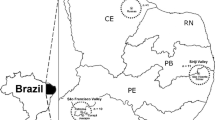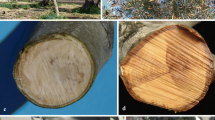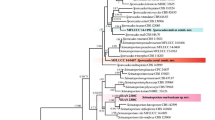Abstract
Three new species of Phaeoacremonium (Pm.) found in discoloured wood of grapevine are described and named Pm. armeniacum, Pm. globosum and Pm. occidentale. Phaeomoniella chlamydospora was isolated from the same vines, but no other Phaeoacremonium spp. were present. Phaeoacremonium spp. have been associated with Petri and esca diseases in grapevine. In pathogenicity trials, the new Phaeoacremonium spp. consistently caused brown discolouration in the inoculated wood. All species caused mortality of cv. 101–14 rootstock cuttings, 22–60% of cuttings surviving 10 weeks after inoculation. Rootstock cv. 5C was less susceptible, with 80–100% of cuttings surviving. The three new species of Phaeoacremonium are genetically distinct from all those previously described and also show subtle morphological differences in the structure and size of the phialides and conidia. Phylogenetic analysis of b-tubulin and actin genes showed that the new species Pm. globosum and Pm. armeniacum are closely related to Pm. argentinense from Argentina, while Pm. occidentale is more closely related to Pm. mortoniae from vineyards in the northern hemisphere. The new species were isolated from rootstock imported into New Zealand ∼25 years ago from California. They are not closely related to species known from grape in California, and no conclusion can be made about whether they were imported in the recent past on infected plants, or if they are indigenous to New Zealand. Many Phaeoacremonium species have a broad host range, and more intensive surveys of the native New Zealand flora and vineyards are needed before their origin can be determined. Additional keywords: Togninia, Vitis vinifera.
Similar content being viewed by others
References
Berg MP, Verhoef HA (1998) Ecological characteristics of a nitrogen-saturated coniferous forest in The Netherlands. Biology and Fertility of Soils 26, 258–267. doi: 10.1007/s003740050377
Carbone I, Kohn LM (1999) A method for designing primer sets for speciation studies in filamentous ascomycetes. Mycologia 91, 553–556. doi: 10.2307/3761358
Damm U, Mostert L, Crous PW, Fourie PH (2008) Novel Phaeoacremonium species associated with necrotic wood of Prunus trees. Persoonia 20, 87–102. doi: 10.3767/003158508X324227
Edwards J, Cunnington J, Salib S, Pascoe IG (2006) Basidiomycetes associated with heart rot of grapevines in Australia. In ‘Fifth international workshop on Grapevine trunk diseases’. Department of Plant Pathology, UC Davis, California, Sept. 21–23, 2006. Abstracts, p. 35.
Eskalen A, Feliciano AJ, Gubler WD (2007) Susceptibility of grapevine pruning wounds and symptom development in response to infection by Phaeoacremonium aleophilum and Phaeomoniella chlamydospora. Plant Disease 91, 1100–1104. doi: 10.1094/PDIS-91-9-1100
Fischer M (2006) Biodiversity and geographic distribution of basidiomycetes causing esca-associated white rot in grapevine: a worldwide perspective. Phytopathologia Mediterranea 45, S30-S42.
Glass NL, Donaldson GC (1995) Development of primer sets designed for use with the PCR to amplify conserved genes from filamentous ascomycetes. Applied and Environmental Microbiology 61, 1323–1330.
Guindon S, Lethiec F, Duroux P, Gascuel O (2005) PHYML online — a web server for fast maximum likelihood-based phylogenetic inference. Nucleic Acids Research 33, W557-W559. doi: 10.1093/nar/gki352
Huelsenbeck JP, Ronquist F (2001) MRBAYES: Bayesian inference of phylogenetic trees. Bioinformatics (Oxford, England) 17, 754–755. doi: 10.1093/bioinformatics/17.8.754
Kim GH, Lim YW, Song YS, Kim JJ (2005) Decay fungi from playground wood products in service using 28S rDNA sequence analysis. Holzforschung 59, 459–466. doi: 10.1515/HF.2005.076
ba]Kornerup A, Wanscher JH (1963) ‘Methuen handbook of colour.’ (Methuen and Co.: London)
Loytynoja A, Goldman N (2005) An algorithm for progressive multiple alignment of sequences with insertions. Proceedings of the National Academy of Sciences of the United States of America 102, 10557–10562. doi: 10.1073/pnas.0409137102
Moore DS, McCabe GP (1996) ‘Introduction to the practice of statistics.’ (WH Freeman & Co.: New York)
Mostert L, Crous PW, Groenewald JZ, Gams W, Summerbell RC (2003) Togninia (Calosphaeriales) is confirmed as teleomorph of Phaeoacremonium by means of morphology, sexual compatibility and DNA phylogeny. Mycologia 95, 646–659. doi: 10.2307/3761941
Mostert L, Groenewald JZ, Summerbell RC, Gams W, Crous PW (2006) Taxonomy and pathology of Togninia (Diaporthales) and its Phaeoacremonium anamorphs. Studies in Mycology 54, 1–115.
Mugnai L, Graniti A, Surico G (1999) Esca (Black Measles) and brown wood-streaking: two old and elusive diseases of grapevines. Plant Disease 83, 404–418. doi: 10.1094/PDIS.1999.83.5.404
O’Donnell K, Cigelnik E (1997) Two divergent intragenomic rDNA ITS2 types within a monophyletic lineage of the fungus Fusarium are nonorthologous. Molecular Phylogenetics and Evolution 7, 103–116. doi: 10.1006/mpev.1996.0376
Posada D, Crondall KA (1998) Modeltest: testing the model of DNA substitution. Bioinformatics (Oxford, England) 14, 817–818. doi: 10.1093/bioinformatics/14.9.817
Réblová M, Mostert L, Gams W, Crous PW (2004) New genera in the Calosphaeriales: Togniniella and its anamorph Phaeocrella, and Calosphaeriophora as anamorph of Calosphaeria. Studies in Mycology 50, 533–550.
Reed-Graham AB (2006) The quality of grafted grapevines grown in a New Zealand nursery. Doctoral Thesis, The University of Auckland.
Ridgway HJ, Stewart JM, Pottinger BM, Carpenter M, Nicol D, Stewart A (2005) Development of an isolate-specific marker for tracking Phaeomoniella chlamydospora infection in grapevines. Mycologia 97, 1093–1101. doi: 10.3852/mycologia.97.5.1093
Ronquist F, Huelsenbeck JP (2003) MrBayes 3: Bayesian phylogenetic inference under mixed models. Bioinformatics (Oxford, England) 19, 1572–1574. doi: 10.1093/bioinformatics/btg180
Rooney-Latham S, Eskalen A, Gubler WD (2005) Occurrence of Togninia minima perithecia in esca-affected vineyards in California. Plant Disease 89, 867–871. doi: 10.1094/PD-89-0867
Swofford DL (2002) ‘PAUP*. Phylogenetic analysis using parsimony (*and other methods). Version 4.’ (Sinauer Associates: Sunderland, MA)
White TJ, Bruns T, Lee S, Taylor JW (1990) Amplification and direct sequencing of fungal ribosomal RNA genes for phylogenetics. In ‘PCR protocols: a guide to methods and applications’. (Eds MA Innis, DH Gelfand, JJ Sninsky, TJ White) pp. 315–322. (Academic Press, Inc.: New York)
Whiteman SA, Stewart A, Ridgway HJ, Jaspers MV (2007) Infection of rootstock mother-vines by Phaeomoniella chlamydospora results in infected young grapevines. Australasian Plant Pathology 36, 198–203. doi: 10.1071/AP07012
Weir BS, Graham AB (2008) Development of an advanced PCR technique to detect grapevine trunk diseases. The Australian & New Zealand Grapegrower & Winemaker 532, 27–29.
Author information
Authors and Affiliations
Corresponding author
Rights and permissions
About this article
Cite this article
Graham, A.B., Johnston, P.R. & Weir, B.S. Three new Phaeoacremonium species on grapevines in New Zealand. Australasian Plant Pathology 38, 505–513 (2009). https://doi.org/10.1071/AP09035
Received:
Accepted:
Issue Date:
DOI: https://doi.org/10.1071/AP09035




